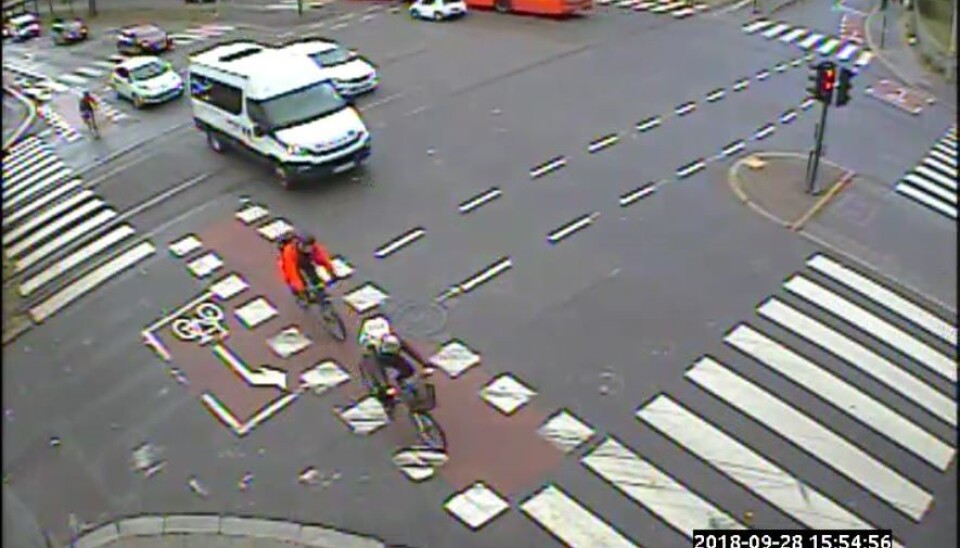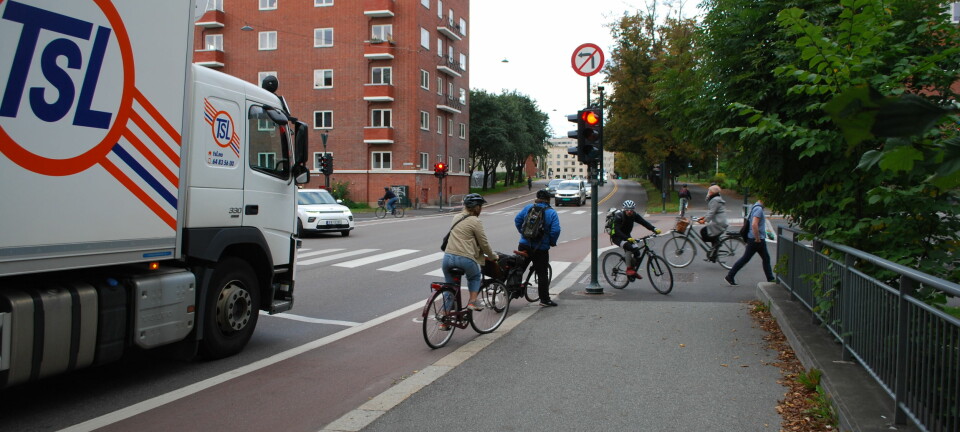
Why don't cyclists just stop at red lights?
Do you ride your bike through red lights? If so, you're not alone. And perhaps sometimes, it should even be legal for you to do so.
It's tempting.
No cars in sight, just one pedestrian on a sidewalk far away. Everything is clear for you to whiz right through.
Do you ride your bike through red lights? If so, you’re not alone.
Two master's students at the Norwegian University of Science and Technology (NTNU) in Trondheim have investigated how many people actually ride through red lights, and why they do so. Similar surveys have also been conducted in Oslo.
Observed cyclists at traffic lights
Andrea Rudolfsen and Vilde Johnson Joranger were not surprised by their results: Roughly 40 per cent of the cyclists they observed rode through a red light.
The students watched two intersections during the Norwegian rush hour between 07:00 and 09:00 and between 15:00 and 16:15.
The intersections they chose to study were areas where they suspected high numbers of cyclists rode through red lights.
Joranger and Rudolfsen also followed up with a survey among 500 active cyclists, of whom more than half lived in Trondheim.
Here, 26 per cent answered that they had cycled through a red light, while 56 per cent said they did not. The remainder replied "maybe".
When do we ride on red?
People often or rarely cycle through a red light depending on the type of intersection. Is there a lot of car traffic, public transport or many pedestrians? Are there bicycle lanes? Are there several lanes in each direction?
In the master's students’ survey, cyclists gave several other reasons why they rode through red lights.
They might be in a rush, they don’t want to slow down, and they see others cycling through red lights.
Here are the main reasons that people gave as to why they rode through red lights:
• If there are no cars at the intersection, people often cycle through red lights.
• If the road that the cyclist will cross is narrow, he or she will more often ride through the red light.
• A cyclist descending a hill at high speed increases the probability that he or she will ride through a red light.
• If a cyclist is going to turn right at the intersection, there is a high probability that he or she will cycle through the red light.
• If the intersection isn’t set up for cyclists, they are more likely to ride through a red light. Riding through the intersection before the light turns green gives cyclists an advantage over motorists, in that it can make cyclists more visible and enable them to avoid being in a car’s blind spot.
Is it sometimes ok to ride through a red light?
One reason that recurred in the study is that the traffic lights "never turn green".
Many traffic lights have so-called detectors in the roadway that respond to heavy vehicles such as cars, but not to bicycles.
This means that a cyclist might stand for several minutes without the light turning green because the detectors do not detect them.
“In that case, there aren’t many alternatives than to ride right through the red light,” says Thomas Jonsson, a professor at NTNU.
Jonsson has supervised the two master's students.
“You can’t stand and wait forever for a vehicle to come and trigger the detectors. Cyclists must be able to trust that the light will turn green,” he said.
Johnsen said detectors for cyclists are a relatively simple measure to resolve conflicts with cyclists and red lights.
Legal right turns make it easier for cyclists
Jonsson also suggested that it be made legal for cyclists to make a right turn at a red light.
The students’ survey shows that cyclists often do this already: Cyclists rarely wait for the green light if they are going to turn right, because they can cycle to the right without coming into conflict with other traffic.
According to the Norwegian Public Roads Administration, this is something that is up for assessment at regular intervals.
“Allowing cyclists to turn right at red is primarily a measure that will contribute to better flow and comfort for cyclists through intersections. Cyclists are sensitive to ‘delays’ that result of having to stop,” Anette Hauge, an advisor at the Norwegian Public Roads Administration, wrote in an email to sciencenorway.no.
But here managers have to consider whether flow and comfort for cyclists should come before traffic safety for other road users, including pedestrians, she said.
In the end, it is up to the Ministry of Transport and Communications to decide if the traffic light rule should be changed for cyclists.
Similar surveys in Oslo gave completely different results
Researchers at the Department of Transport Economics (TØI) have done studies similar to what the master's students did in Trondheim, but in Oslo.
The researchers set up cameras at two traffic lights where people cycle a lot. Here the numbers were completely different.
On Sognsveien, only 1 per cent cycled through a red light, while on Kierschows gate it was 7 per cent.
“This is because the intersections are very different,” said Aslak Fyhri, a researcher at TØI and one of the researchers behind the red light count in Oslo.
He initially wanted to find out if bike racks in front of the traffic lights contributed to fewer people cycling on red. They did, Fyhri said.

The traffic and the tram
Fyhri explains the low numbers in Oslo by the amount of traffic at the intersections.
Sognsveien and Kiershows gate are two very busy roads, especially during rush hour.
Here, pedestrians, motorists, cyclists, electric scooters, buses and trams meet in often difficult situations.
“There would be much higher numbers in an intersection with less traffic than what we have at these two,” says Fyhri.
He points out that the tram in particular is a real obstacle to cycling through a red light. It comes thundering up Sognsveien without having to give way to anyone. A cyclist can do little against the blue trams.
“You don’t cross on a red light when you know that the tram is nearby,” says Fyhri.
The Norwegian Public Roads Administration conducted a survey in 2004 which shows that one in three cyclists rides through red lights, which is more similar to the results from the surveys in Trondheim. It was carried out with physical observations at traffic lights all over Norway, except in the north.
Another survey was conducted by ABC News when they set up a camera at a traffic light in central Oslo on a Monday afternoon in 2018. Thirty-two per cent of the cyclists caught on camera cycled through a red light.
Harmful to reputation
According to Thomas Jonsson, the NTNU supervisor, there are few registered accidents as a result of cyclists cycling on red.
Master's student Vilde Joranger is therefore more concerned about other road users' attitudes towards cyclists.
“It’s a well-known fact that some motorists dislike cyclists who ride in the road and think they take too much space,” she says.
“If lots of cyclists break traffic rules, such as cycling through a red light, I think the attitudes that motorists have towards cyclists will worsen. This in turn could result in drivers paying less attention to cyclists,” she said.
Translated by: Nancy Bazilchuk
———
Read the Norwegian version of this article on forskning.no
































